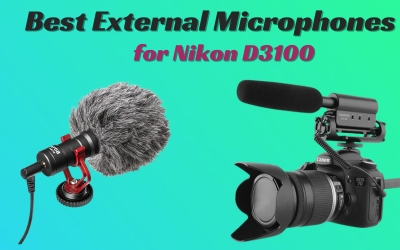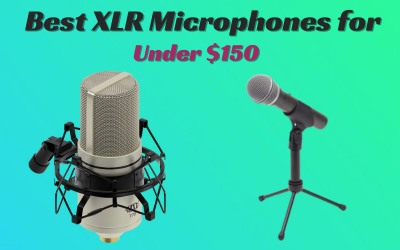Looking for the best condenser microphones for vocals? Look no further! Whether you’re a professional musician or just starting out, a high-quality condenser mic can make all the difference in your recordings.
In this article, we’ll break down the top options on the market and explain what to look for when making your purchase. Get ready to take your vocal recordings to the next level! Keep reading to find out which mics made the cut and why.
Table of Contents
ToggleBest Condenser Microphones for Vocals
If you’re looking to record high-quality vocals, a condenser microphone is an essential tool for achieving professional-level sound. Condenser microphones are known for their sensitivity and ability to capture detailed nuances in vocal performances. In this roundup, we’ve compiled a list of the best condenser microphones for vocals, taking into consideration factors such as sound quality, durability, and affordability. Whether you’re a professional musician or a beginner looking to up your recording game, there’s a microphone on this list that will suit your needs.
1. RØDE NT1 5th Gen Large-diaphragm Studio Condenser Microphone
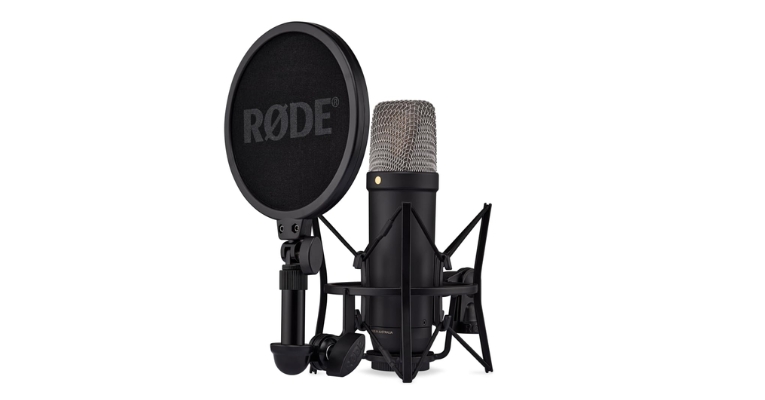
The RØDE NT1 5th Generation condenser microphone is a game-changer for professionals seeking top-tier vocal recording capabilities. This microphone seamlessly marries cutting-edge technology with a nod to its predecessor’s legendary sound quality, making it a standout choice for a diverse array of applications.
The NT1 5th Generation is a versatile powerhouse, offering both XLR and USB connectivity, rendering it an all-in-one digital recording solution. Its integration of RØDE’s ultra-low-noise, high-gain Revolution Preamp and high-resolution analog-to-digital conversion ensures pristine, professional-grade recordings, elevating the quality of any project.
For professionals, the microphone’s adaptability is a key advantage. Whether capturing the emotive nuances of a vocal performance, the intricate details of an acoustic guitar, or the thunderous resonance of a grand piano, the NT1 5th Generation delivers studio-grade sound quality across the board.
This adaptability makes it an indispensable tool for a wide range of creative endeavors, from producing captivating podcasts and voiceovers to crafting immersive musical experiences.
However, it’s important to note that the NT1 5th Generation comes with a higher price tag compared to some competing models. Additionally, a few users have reported minor issues with the USB connection, which may require troubleshooting. Furthermore, the absence of a carrying case could pose a minor inconvenience for those frequently on the move. Nonetheless, these concerns can be easily mitigated by the microphone’s exceptional performance and the potential for long-term value it offers.
Pros
- Legendary sound quality
- XLR and USB connectivity
- Ultra-low-noise, high-gain Revolution Preamp
- High-resolution analog-to-digital conversion
Cons
- Higher price point
- Potential USB connection issues
- Lack of included carrying case
2. FIFINE Studio Condenser USB Microphone
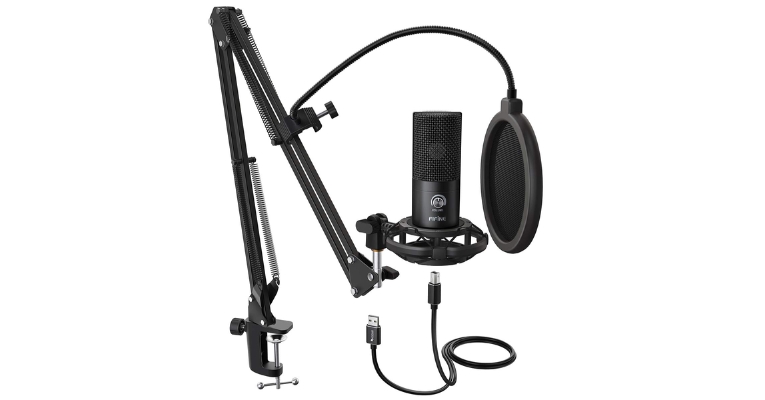
The FIFINE Studio Condenser USB Microphone Kit is a game-changer for professionals seeking an affordable yet high-quality vocal recording solution. This microphone stands out for its user-friendly USB output, ensuring a hassle-free setup and seamless connection to your PC or laptop. The cardioid condenser capsule delivers crystal-clear audio, making it perfect for professional communication, content creation, and recording.
One of the standout features of this microphone is the durable arm set, which includes a broadcast suspension boom scissor arm and double pop filter. These tools are invaluable for capturing clear and professional-quality vocals, whether for podcasting, voiceovers, or online conferencing. The low-profile design of the microphone ensures unobstructed performance, making it an ideal choice for professionals who need to record podcasts or create video content without any facial obstructions.
The accessory package is equally impressive, featuring a studio-grade shock mount, premium 8.2′ USB cable, and a user manual. The sturdy all-steel construction of the scissor arm stand ensures durability and reliability, catering to the demands of professional use.
While the microphone offers numerous benefits, it’s important to note a few potential drawbacks. Some users have reported incompatibility with Xbox and phones, and the microphone may pick up background noise. Additionally, a few users have experienced issues with the stability of the mic stand. However, these challenges can be mitigated with alternative setup options and careful consideration of the recording environment.
Pros
- User-friendly USB output
- Crystal-clear audio quality
- Durable arm set for professional recording
- Low-profile design for unobstructed performance
Cons
- Incompatibility with Xbox and phones
- Potential background noise pickup
- Stability issues with the mic stand
3. ALABS XLR Condenser Microphone
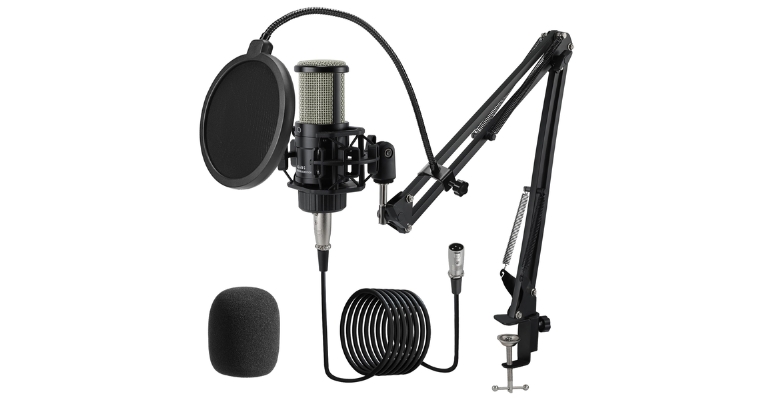
The ALABS XLR Condenser Microphone is a top-notch choice for professionals seeking a high-quality recording microphone tailored for vocal performance. Its standout feature is the large 25mm electret condenser capsule and professional sound chipset, which guarantee crystal clear, high-resolution audio.
This makes it an excellent tool for capturing the nuances and subtleties of the human voice, essential for professional recordings.
The cardioid pickup pattern is another standout feature, accurately capturing sound sources directly in front while minimizing interference from surrounding noise. This ensures that the focus remains on the primary sound source, resulting in clear and pristine recordings. Moreover, the inclusion of a shock mount, pop filter, and windshield effectively reduces unwanted noise caused by vibration, wind, and saliva, maintaining the clarity and purity of the recorded voice.
However, it’s important to note that the ALABS XLR Condenser Microphone requires an external power source and uses an XLR interface, necessitating a connection to an audio interface, mixer, or preamp for operation. Additionally, the absence of a phantom power supply in the package means that users intending to connect the microphone to their PC, Pad, or Phone will need to make a separate purchase. Furthermore, while the all-metal base provides stability, the suitability of the included boom arm may vary for different users.
Pros
- Crystal clear, high-resolution audio
- Accurate cardioid pickup pattern
- Effective noise reduction features
Cons
- Requires external power source
- XLR interface necessitates additional equipment
- Separate purchase required for phantom power supply
4. Neumann TLM 102 Studio Set
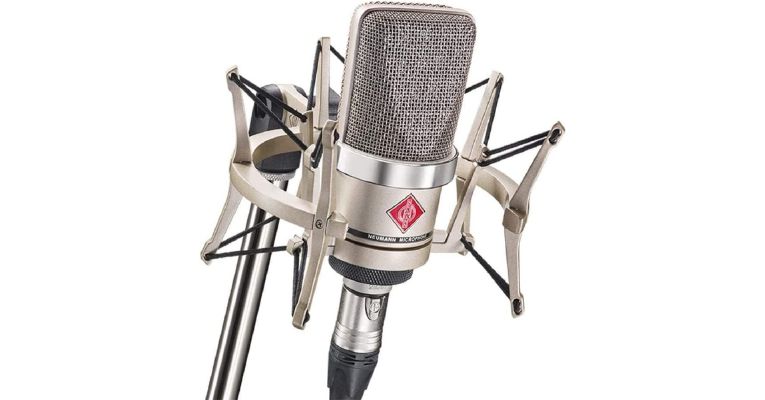
The Neumann TLM 102 Studio Set is a top-notch choice for professionals seeking a high-quality condenser microphone tailored for vocal recording. This compact powerhouse boasts a genuine Neumann large diaphragm capsule, delivering exceptional sound quality with a beautifully balanced tone. Its transformerless circuitry allows for high sound pressure levels without distortion, making it versatile for capturing a wide range of instruments and vocals.
One standout feature is the gentle treble lift, which imparts a silky smoothness to high frequencies, rendering it ideal for capturing the nuances of vocal performances. The integrated pop screen effectively minimizes plosives and unwanted noise, ensuring pristine vocal recordings. However, its sensitivity mandates a quiet recording environment to mitigate background noise.
In the professional realm, the TLM 102 Studio Set shines in capturing emotive vocal performances, enhancing the richness of acoustic instruments, and delivering crisp, detailed recordings of percussion. Its cardioid pattern and integrated pop screen make it an ideal choice for solo vocalists, podcasters, and voice-over artists seeking a refined, studio-quality sound.
Pros
- Exceptional sound quality
- Versatile for various instruments
- Gentle treble lift for silky smooth vocals.
Cons
- Higher price point
- Sensitivity to background noise
- Directional cardioid pattern for multi-source recording.
5. MAONO XLR Condenser Microphone
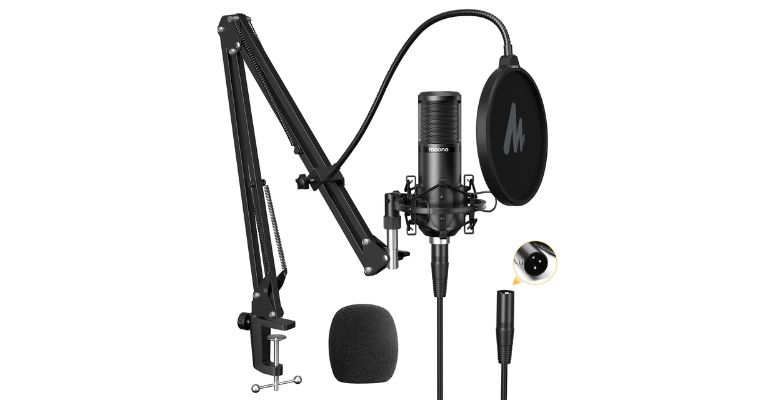
The MAONO XLR Condenser Microphone is a game-changer for professionals seeking top-notch vocal recording quality without breaking the bank. Let’s dive into the standout features that make this microphone a compelling choice for your professional endeavors.
First off, the built-in large Dia.16mm condenser capsule delivers exceptional sound quality, ensuring that your vocal recordings, podcasts, live streams, and online conversations are nothing short of captivating. The cardioid pointing feature works wonders in minimizing ambient noise, while the shock absorber effectively reduces vibration noise, resulting in crystal-clear and immersive vocal outputs.
Moreover, the microphone’s full metal construction not only provides robust protection but also exudes a professional aesthetic. The adjustable scissors arm bracket adds a touch of convenience, offering durability and portability for seamless on-the-go use.
However, it’s important to note that the microphone requires 48V phantom power, necessitating connection to an audio interface or mixer for optimal functionality. Additionally, while the windscreen cap and pop filter may not completely eliminate wind and saliva interference, employing alternative solutions such as additional wind protection can mitigate these issues. Furthermore, the microphone arm’s limited flexibility may not suit all setups, but creative positioning and mounting adjustments can address this limitation effectively.
Related Post
- Explaining the life expectancy of condenser mics
- Tips to Resolve Condenser Mic Quietness Issues
- Do condenser microphones have a tendency to break?
- Causes and solutions for hiss in condenser mics
Pros
- Exceptional sound quality
- Noise reduction
- Durable construction.
- High-resolution analog-to-digital conversion
Cons
- Requires 48V phantom power
- Limited wind and saliva interference reduction
- Inflexible microphone arm.
6. Shure BETA 87A Studio Grade Vocal Microphone
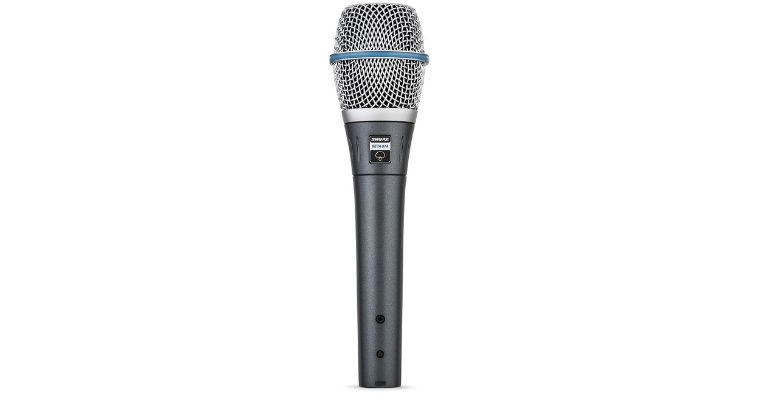
The Shure BETA 87A is a game-changer for professionals seeking top-notch vocal performance. With its smooth frequency response and gradual presence rise, this microphone delivers bright, clear vocals that stand out in any studio or live setting. The supercardioid polar pattern ensures superior gain-before-feedback, making it an ideal choice for professional sound reinforcement, broadcasting, and studio recording applications.
This microphone’s controlled low-frequency roll-off effectively eliminates the proximity effect, preventing any unwanted “boomy” sounds. Its tight supercardioid pattern provides maximum isolation, ensuring minimal off-axis coloration and maximum focus on the vocalist. Additionally, the characteristic Shure presence rise brightens the upper midrange, adding a touch of studio-grade clarity to live performances.
The BETA 87A boasts a wide dynamic range of 117 dB and low distortion characteristics, capturing vocals with exceptional detail and accuracy. The built-in pop filter and advanced cartridge shock-mount system further enhance the audio quality by reducing undesirable wind, breath sounds, and handling noise.
Notably, its low susceptibility to RFI and electromagnetic hum ensures a clean and clear sound, even in noisy environments.
While the microphone’s feedback resistance is commendable, users should exercise caution with gain settings to avoid potential feedback issues. At higher volumes, it may start to pick up background sounds, so careful consideration of the performance environment is essential. Although it may not be the perfect fit for all vocal types or performances, the Shure BETA 87A remains a top contender for professionals seeking exceptional vocal clarity and accuracy.
Pros
- Smooth frequency response
- Superior gain-before-feedback
- Low susceptibility to RFI
Cons
- Potential feedback issues
- background sound pickup
7. Marantz Professional MPM-1000
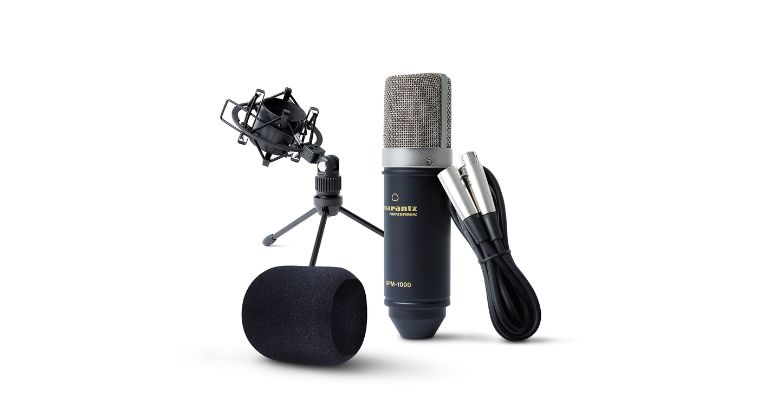
The Marantz Professional MPM-1000 condenser microphone is a game-changer for professionals seeking exceptional audio performance. Let’s dive into the features that make it an excellent choice for your vocal work.
The MPM-1000 boasts a directional cardioid polar pattern and pure-aluminum-plated, 18mm-diameter-diaphragm condenser capsule, ensuring minimal interference from ambient noise. With its wide-ranging frequency response of 20–20,000Hz, high sensitivity, and low signal-to-noise ratio, this microphone captures every subtle nuance of your vocals, bringing them to life with unparalleled clarity.
This microphone’s compact footprint and lightweight form factor make it a perfect companion for on-the-go audio capture. Whether you’re recording vocals, melodic instruments, or drum kits, the MPM-1000 is designed to deliver exceptional results in any setting.
In real-world scenarios, the MPM-1000 shines in podcasting applications, capturing high-quality audio from vocalists, and enhancing the depth of melodic instruments and percussion. However, some users may find the included windscreen to be inadequate in reducing unwanted noise. Additionally, the microphone stand included in the package may wobble during use, and the XLR cable provided might be too short for certain setups. Consider investing in a sturdier microphone stand and an extension cable to address these concerns effectively.
Pros
- Directional cardioid polar pattern
- Wide-ranging frequency response
- High sensitivity and low signal-to-noise ratio
Cons
- Inadequate windscreen for reducing noise
- Unstable included microphone stand
- Short XLR cable
8. FIFINE XLR Microphone
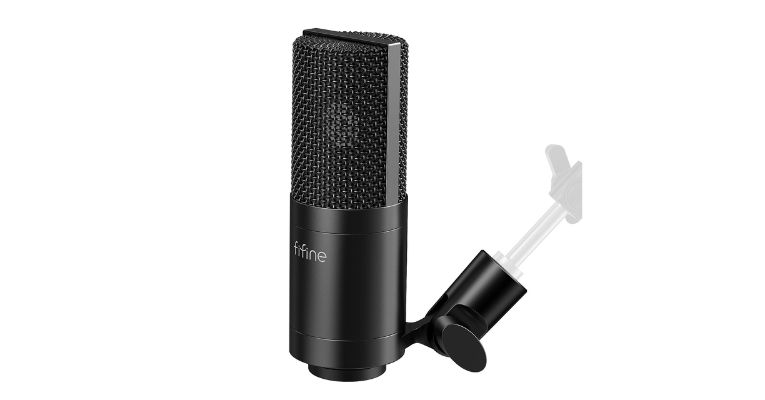
The FIFINE XLR condenser microphone is a versatile and affordable option for professionals seeking to elevate their vocal recordings. This microphone boasts a built-in 16mm diaphragm that captures sound sources with remarkable clarity and accuracy. Its wide frequency response of 30Hz to 20kHz ensures a balanced reproduction of vocals, delivering rich mids, lows, and highs for a captivating listening experience.
The microphone’s cardioid polar pattern excels at isolating the desired sound source while minimizing ambient noise, making it ideal for professional vocal recordings in home studios. Whether delivering powerful vocals or nuanced voice-overs, the FIFINE XLR microphone ensures warm, distortion-free recordings, even for deeper voices.
While the microphone’s performance is commendable, it’s important to note that it may require 48V phantom power for optimal functionality, which may necessitate an additional purchase. Additionally, in untreated acoustic spaces, some background noise may be picked up. Furthermore, the stand’s sturdiness might be insufficient for heavier microphones, requiring careful consideration when selecting accessories.
Related Post
- Solving Muffled Sound Problems with Condenser Microphones
- Signs Your Condenser Mic May Be Faulty
- Tapping and potential harm to microphones
Pros
- Built-in 16mm diaphragm for clear and accurate sound reproduction
- Wide frequency response for balanced vocal recording
- Effective noise isolation for professional-quality results
Cons
- May require 48V phantom power for optimal functionality
- Potential for picking up background noise in untreated spaces
- Stand may not be suitable for heavier microphones
9. PROAR Condenser Microphone XLR
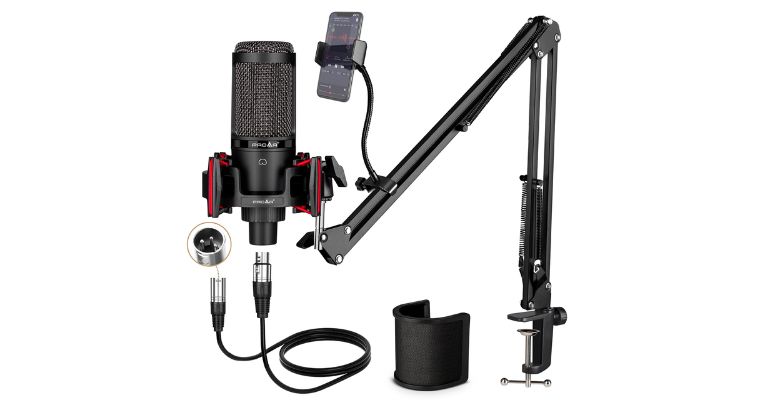
The PROAR Condenser Microphone XLR is a powerhouse for professionals seeking top-notch vocal performance. With its Dia.14mm condenser capsule and wide frequency response, this microphone delivers professional sound quality that’s perfect for a range of applications, from recording to streaming.
The cardioid pickup pattern ensures accurate sound reproduction while effectively canceling out background noise, providing pristine vocal recordings in any environment.
This microphone is built to last, featuring a sturdy full metal construction and an adjustable scissor boom arm that allows for 360° rotation, ensuring easy positioning for optimal vocal capture. The shock mount further enhances the recording experience by minimizing noise caused by vibration, resulting in clear and smooth recordings every time.
While the PROAR Condenser Microphone XLR offers exceptional performance, it’s important to note that an external power source, such as 48V phantom power, audio interface, mixer, or preamp, is required for operation. Additionally, some users have reported issues with the phone holder and noise when using phantom power. However, these concerns can be easily addressed, and the microphone’s one-year warranty and excellent customer service provide peace of mind.
Pros
- Professional sound quality with Dia.14mm condenser capsule
- Cardioid pickup pattern for accurate sound and noise cancellation
- Sturdy full metal construction and adjustable scissor boom arm
- Wide frequency response for versatile vocal applications
Cons
- External power source required
- Phone holder may require adjustment
- Potential noise issues with phantom power
10. ALABS AC88 XLR Podcast Microphone
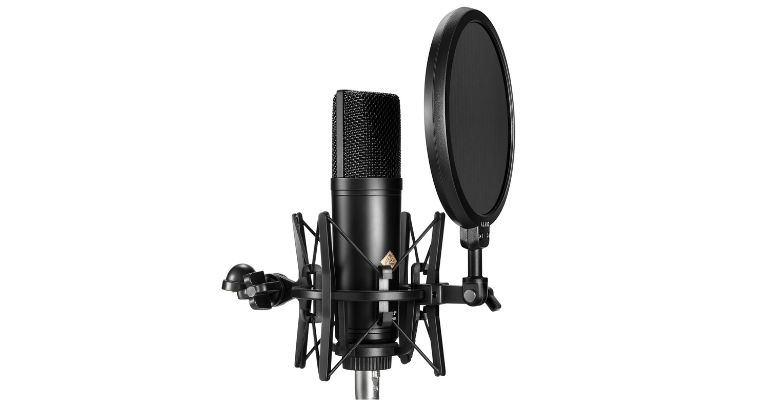
The ALABS AC88 XLR Podcast Microphone is a versatile and reliable choice for professionals seeking top-notch recording performance. Its gold-sputtered large diaphragm and phantom-powered preamplifier ensure exceptional audio transparency and nuanced sound capture, making it ideal for vocal recording in various environments.
The microphone’s high sensitivity allows for crystal-clear recordings across diverse sound levels, ensuring that every vocal nuance is faithfully reproduced. Its wide dynamic range and frequency range further enhance its recording capabilities, making it suitable for capturing subtle vocal details and dynamic changes.
The inclusion of a shock mount and pop filter provides added protection and ensures optimal recording results, even in challenging acoustic environments.
While the microphone requires 48v phantom power to operate, its sturdy metal casing offers durability and safeguards internal components from external impacts. The included boom arm, pop filter, and shock mount contribute to a comprehensive recording setup, addressing potential challenges such as external vibrations and unwanted sound interference.
Pros
- High sensitivity for nuanced vocal recordings
- Wide dynamic range and frequency range
- Inclusive shock mount and pop filter
Cons
- Requires 48v phantom power
- Limited color options
- Considerable weight may be a concern
Buying Guide
When it comes to choosing the best condenser microphone for vocals, there are a few factors to consider. Here are some key features to look for:
Polar Pattern
The polar pattern of a microphone refers to its sensitivity to sound from different directions. For vocal recording, a cardioid polar pattern is usually the best choice as it picks up sound from the front while reducing background noise from the sides and rear.
However, if you plan to record multiple singers or instruments at once, an omnidirectional pattern may be more suitable.
Frequency Response
The frequency response of a microphone refers to the range of frequencies it can pick up. For vocals, a microphone with a flat frequency response is ideal as it captures the natural sound of the singer’s voice. However, some microphones may have a slight boost in certain frequencies, which can be useful for emphasizing certain aspects of the voice.
Sensitivity and SPL Handling
The sensitivity of a microphone refers to its ability to pick up quiet sounds, while SPL handling refers to its ability to handle loud sounds without distortion. For vocal recording, a microphone with a high sensitivity and good SPL handling is important to capture the nuances of the singer’s voice without clipping or distortion.
Other Features
Other features to consider include the microphone’s self-noise level, which refers to the amount of noise the microphone produces on its own, and its connectivity options, such as USB or XLR. Additionally, some microphones may come with accessories such as shock mounts or pop filters, which can improve the quality of the recording.
When choosing a condenser microphone for vocals, it’s important to consider your specific needs and budget. By keeping these key features in mind, you can find the best microphone to suit your recording needs.
Conclusion
In summary, when it comes to choosing the best condenser microphone for vocals, there are several factors to consider. You should look for a microphone with a cardioid polar pattern, a high SPL handling capability, and a frequency response that suits your voice.
Some of the top options on the market today include the RØDE NT1 5th, Shure BETA 87A, and Neumann TLM 103. Each of these microphones has its own unique features and benefits that make it a great choice for recording vocals.
Remember to also consider your budget and recording environment when making your decision. With the right condenser microphone, you can capture clear, professional-quality vocals that will make your recordings stand out.
Frequently Asked Questions
What are the top rated condenser microphones for home studio vocal recording?
The top-rated condenser microphones for home studio vocal recording include the Audio-Technica AT4053B, Neumann TLM 103, and AKG Pro Audio C414. These microphones are known for their superior sound quality, clarity, and versatility. They are also highly recommended by professional sound engineers and vocalists.
Which budget condenser microphones are recommended for vocalists?
If you’re on a budget, some of the best condenser microphones for vocalists include the Audio-Technica AT2020, Rode NT1-A, and AKG Pro Audio P220. These microphones are affordable and offer excellent sound quality for vocal recording.
How do Rode condenser microphones compare for vocal recording?
Rode condenser microphones are known for their high-quality sound and durability. They offer a wide range of microphones for vocal recording, including the Rode NT1-A, Rode NT2-A, and Rode NT2000. These microphones are popular among vocalists and sound engineers for their clarity, warmth, and versatility.
What are the preferred condenser microphones for vocalists in gaming streams?
For vocal recording in gaming streams, the Audio-Technica AT2035, Razer Seiren Elite, and Blue Yeti are some of the preferred condenser microphones. These microphones are known for their clear sound quality, ease of use, and affordable price.
What features make AKG condenser microphones stand out for vocal recording?
AKG condenser microphones are known for their exceptional sound quality and versatility. They offer a wide range of microphones for vocal recording, including the AKG Pro Audio C414, AKG Pro Audio C214, and AKG Pro Audio C1000S. These microphones are known for their clarity, warmth, and ability to capture every detail of the vocal performance.
Which microphones are commonly used by professional singers in the industry?
Some of the most commonly used microphones by professional singers in the industry include the Neumann U87, Shure SM7B, and AKG Pro Audio C12. These microphones are known for their exceptional sound quality, clarity, and ability to capture every nuance of the vocal performance. They are also highly recommended by sound engineers and producers in the industry.

